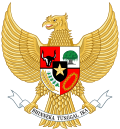| Position | Name | Took office | Left office |
|---|
| Coordinating ministers |
Coordinating Minister of Politics and Security
(renamed Coordinating Minister of Politics, Social and Security since the first reshuffle) | Wiranto | 29 October 1999 (1999-10-29) | 15 February 2000 (2000-02-15) |
| Suryadi Sudirja | 15 February 2000 (2000-02-15) | 26 August 2000 (2000-08-26) |
| Susilo Bambang Yudhoyono | 26 August 2000 (2000-08-26) | 1 June 2001 (2001-06-01) |
| Agum Gumelar | 1 June 2001 (2001-06-01) | 23 July 2001 (2001-07-23) |
| Coordinating Minister of the Economy, Finance, and Industry | Kwik Kian Gie | 29 October 1999 (1999-10-29) | 23 July 2000 (2000-07-23) |
| Rizal Ramli | 1 June 2001 (2001-06-01) | 12 June 2001 (2001-06-12) |
| Burhanuddin Abdullah | 12 June 2001 (2001-06-12) | 23 July 2001 (2001-07-23) |
Coordinating Minister of People's Welfare and Abolition of Poverty
(combined with Coordinating Minister of Politics and Security since the first reshuffle) | Hamzah Haz | 29 October 1999 (1999-10-29) | 26 November 1999 (1999-11-26) |
| Basri Hasanuddin | 26 November 1999 (1999-11-26) | 26 August 2000 (2000-08-26) |
| Departmental ministers |
| Minister of Home Affairs | Suryadi Sudirja | 29 October 1999 (1999-10-29) | 23 July 2001 (2001-07-23) |
| Minister of Foreign Affairs | Alwi Shihab | 29 October 1999 (1999-10-29) | 23 July 2001 (2001-07-23) |
| Minister of Defence | Juwono Sudarsono | 29 October 1999 (1999-10-29) | 26 August 2000 (2000-08-26) |
| Mahfud MD | 26 November 1999 (1999-11-26) | 20 July 2001 (2001-07-20) |
| Agum Gumelar | 20 July 2001 (2001-07-20) | 23 July 2001 (2001-07-23) |
Minister of Laws and Legislation
(renamed Minister of Justice and Human Rights since the first reshuffle) | Yusril Ihza Mahendra | 29 October 1999 (1999-10-29) | 7 February 2001 (2001-02-07) |
| Baharuddin Lopa | 9 February 2001 (2001-02-09) | 1 June 2001 (2001-06-01) |
| Marsillam Simanjuntak | 1 June 2001 (2001-06-01) | 20 July 2001 (2001-07-20) |
| Mahfud MD | 20 July 2001 (2001-07-20) | 23 July 2001 (2001-07-23) |
| Minister of Finance | Bambang Sudibyo | 29 October 1999 (1999-10-29) | 26 August 2000 (2000-08-26) |
| Prijadi Praptosuhardjo | 26 June 2000 (2000-06-26) | 12 June 2001 (2001-06-12) |
| Rizal Ramli | 12 June 2001 (2001-06-12) | 23 July 2001 (2001-07-23) |
Minister of Mining and Energy
(renamed Minister of Energy and Mineral Resources since the first reshuffle) | Susilo Bambang Yudhoyono | 29 October 1999 (1999-10-29) | 26 August 2000 (2000-08-26) |
| Purnomo Yusgiantoro | 26 August 2000 (2000-08-26) | 23 July 2001 (2001-07-23) |
| Minister of Industry and Trade | Jusuf Kalla | 29 October 1999 (1999-10-29) | 26 April 2000 (2000-04-26) |
| Luhut Binsar Panjaitan | 26 April 2000 (2000-04-26) | 23 July 2001 (2001-07-23) |
Minister of Agriculture
(renamed Minister of Agriculture and Forestry since the first reshuffle) | M. Prakosa | 29 October 1999 (1999-10-29) | 26 August 2000 (2000-08-26) |
| Bungaran Saragih | 26 August 2000 (2000-08-26) | 23 July 2001 (2001-07-23) |
Minister of Forestry and Plantation
(renamed Junior Minister of Forestry since the first reshuffle) | Nurmahmudi Ismail | 29 October 1999 (1999-10-29) | 15 March 2001 (2001-03-15) |
| Marzuki Usman | 15 March 2001 (2001-03-15) | 23 July 2001 (2001-07-23) |
| Minister of Transportation | Agum Gumelar | 29 October 1999 (1999-10-29) | 1 June 2001 (2001-06-01) |
| Budi Mulyawan Suyitno | 1 June 2001 (2001-06-01) | 23 July 2001 (2001-07-23) |
Minister of Maritime Exploration
(renamed Minister of Maritime Affairs and Fisheries since the first reshuffle) | Sarwono Kusumaatmaja | 29 October 1999 (1999-10-29) | 1 June 2001 (2001-06-01) |
| Rokhmin Dahuri | 1 June 2001 (2001-06-01) | 23 July 2001 (2001-07-23) |
Minister of Manpower
(renamed Minister of Manpower and Transmigration since the first reshuffle) | Bomer Pasaribu | 29 October 1999 (1999-10-29) | 26 August 2000 (2000-08-26) |
| Al Hilal Hamdi | 26 August 2000 (2000-08-26) | 23 July 2001 (2001-07-23) |
Minister of Health
(renamed Minister of Health and Social Welfare since the first reshuffle) | Achmad Sujudi | 29 October 1999 (1999-10-29) | 23 July 2001 (2001-07-23) |
| Minister of National Education | Yahya Muhaimin | 29 October 1999 (1999-10-29) | 23 July 2001 (2001-07-23) |
| Minister of Religious Affairs | Tolchah Hasan | 29 October 1999 (1999-10-29) | 23 July 2001 (2001-07-23) |
Minister of Settlement and Regional Development
(renamed Minister of Settlement and Regional Infrastructure since the first reshuffle) | Erna Witoelar | 29 October 1999 (1999-10-29) | 23 July 2001 (2001-07-23) |





